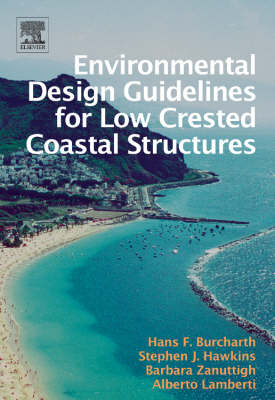
Environmental Design Guidelines for Low Crested Coastal Structures
Elsevier Science Ltd (Verlag)
978-0-08-044951-7 (ISBN)
The effect of manmade activities is primarily local but can extend far away from the location of intervention. This underlines the importance of establishing coastal zone management plans covering large stretches of coastlines.
In recent years, interest in Low Crested Structures (coastal defense structures with a low-crest) has been growing together with awareness of the sensitivity to environmental impacts produced by coastal defenses.
The relation between wave climate, beach erosion, beach defence means, habitat changes and beach value, which clearly exists based on EC research results, suggests the necessity of an integrated approach when designing coastal protection schemes. In accordance with this need, the present design guidelines cover structure stability and construction problems, hydro and morphodynamic effects, environmental effects (colonisation of the structure and water quality), societal and economic impacts (recreational benefits, swimming safety, beach quality).
Environmental Design Guidelines for Low Crested Coastal Structures is specifically dedicated to Low Crested Structures, and provides methodological tools both for the engineering design of structures and for the prediction of performance and environmental impacts of such structures. A briefing of current best practice for local and national planning authorities, statutory agencies and other stakeholders in the coastal zone is also covered.
Presented in a generic way, this book is appropriate throughout the European Union, taking into account current European Commission policy and directives for the promotion of sustainable development and integrated coastal zone management.
Hans Falk Burcharth is a Professor in the Department Of Civil Engineering at Aalborg University. Dr. Barbara Zanuttigh is an Associate Professor of Hydraulic Engineering at the University of Bologna, Italy. Her research is focused on Coastal Engineering, and specifically: wave-structure interaction, risk assessment and management, "working with nature" approaches and wave energy converters. She has been involved in many research projects, and was the Coordinator of the FP7 THESEUS project "Innovative technlologies for safer European coasts in a changing climate" (www.theseusproject.eu). She has been visiting researcher or collaborator with numerous national and international laboratories and universities, the most important experience being a visiting scholar of Coastal Structures at Delft University of Technology. She received the Torricelli Prize assigned by the Italian Hydraulic Group (2008) for the significant contribution to applied fluid mechanics. She is author of more than 150 papers, editor of a special issue of Coastal Engineering, and co-editor of Environmental Design Guidelines for Low Crested Coastal Structures. She has been supervising PhD students and a number of master and bachelor theses.
Part I. Guidelines
1. Definition of LCSs covered by the guidelines
2. Function of LCSs
3. Objectives and target effects of LCSs
4. Outline of design procedure
5. Initial considerations
6. Investigation of environmental conditions
7. Conceptual/pre-design alternatives
8. Detailed design of preferred scheme
9. Materials for LCSs
10. Construction of LCSs
Part II. Appendix
11. Case Studies
12. An example of environmental design of coastal defence
Part III. Tools
13. Design tools related to engineering
14. Background knowledge and tools for prediction of ecological impacts
15. Design tools related to socio-economics
| Erscheint lt. Verlag | 16.10.2007 |
|---|---|
| Verlagsort | Oxford |
| Sprache | englisch |
| Maße | 165 x 240 mm |
| Gewicht | 910 g |
| Themenwelt | Sachbuch/Ratgeber ► Natur / Technik ► Natur / Ökologie |
| Naturwissenschaften ► Biologie ► Ökologie / Naturschutz | |
| Technik ► Bauwesen | |
| Technik ► Umwelttechnik / Biotechnologie | |
| ISBN-10 | 0-08-044951-4 / 0080449514 |
| ISBN-13 | 978-0-08-044951-7 / 9780080449517 |
| Zustand | Neuware |
| Haben Sie eine Frage zum Produkt? |
aus dem Bereich


